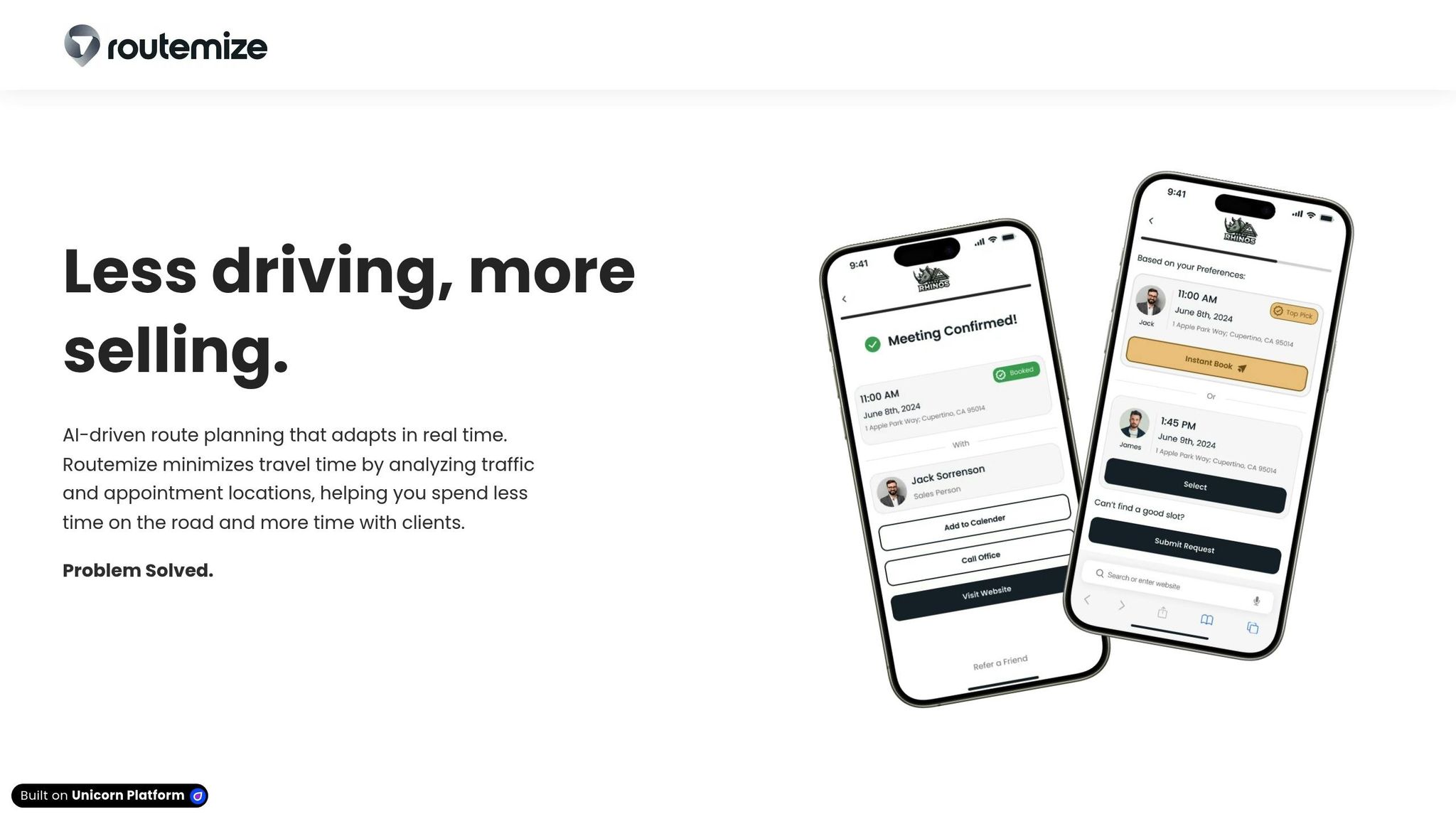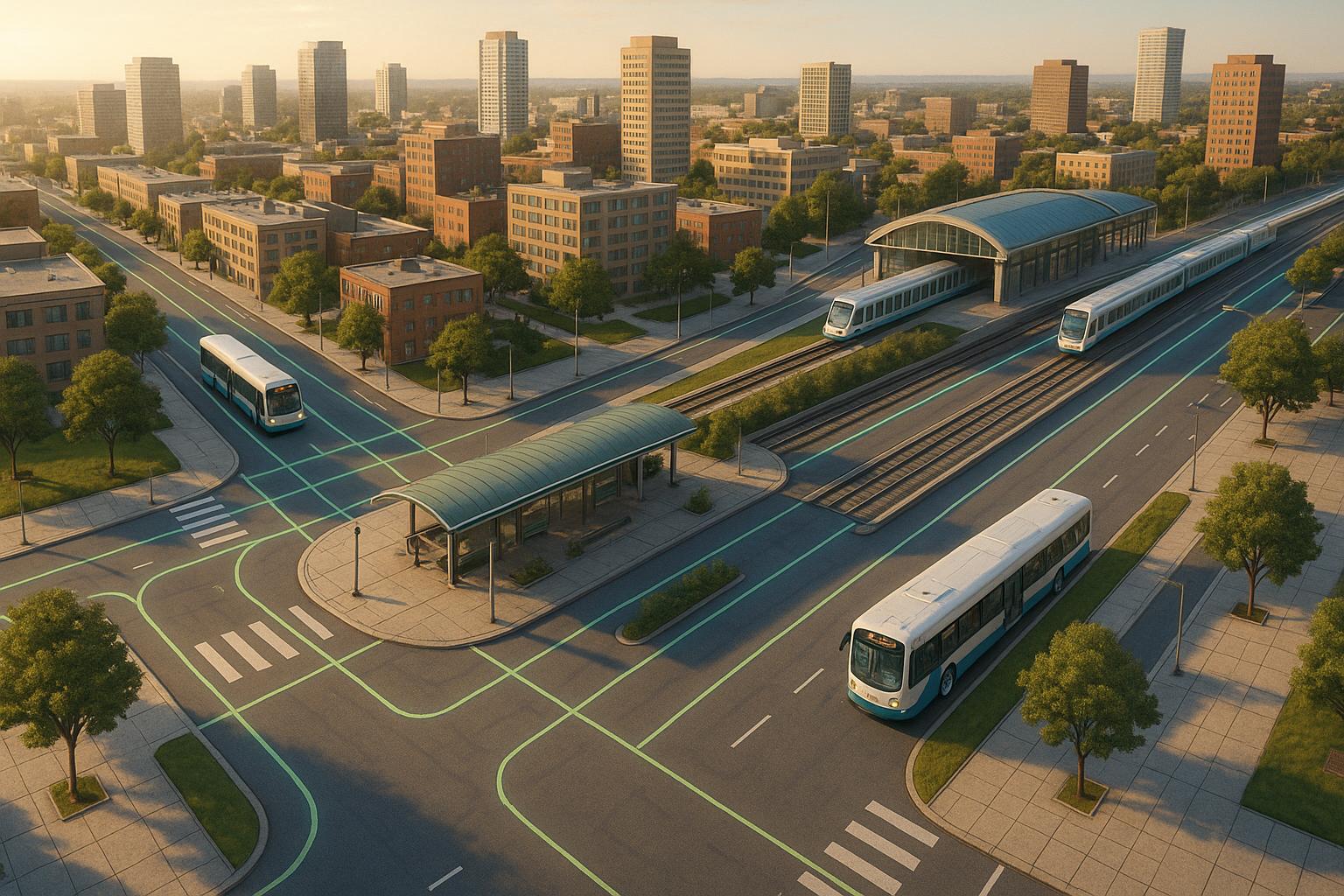AI dispatch algorithms are transforming fleet management by making operations faster, more efficient, and cost-effective. These systems use real-time data like GPS, traffic updates, and delivery schedules to optimize routes, reduce delays, and save fuel. Here's a quick rundown of their benefits:
- Smarter Routing: AI tools like Routemize create dynamic routes based on live traffic and appointments.
- Efficient Scheduling: Automatically balance workloads and reschedule tasks to keep deliveries on track.
- Cost Savings: Minimize fuel usage, idle time, and vehicle wear while cutting labor costs.
Key Features:
- Real-Time Data Processing: Adjust routes instantly based on traffic, weather, or delivery windows.
- Customer Benefits: Accurate ETAs, shorter delivery windows, and instant updates improve satisfaction.
- Future-Ready: Supports predictive maintenance and adapts to self-driving vehicles.
Next Steps: Start by auditing your current systems, ensure compatibility with AI tools, and run a pilot program to test results. AI dispatch systems are a game-changer for fleets looking to improve efficiency and reduce costs.
AI-powered routing and dispatch, streamlined diagnostic ...
AI Dispatch Algorithm Basics
AI dispatch algorithms rely on three main technologies to tackle fleet management challenges. These include machine learning for identifying patterns, analytics tools to predict disruptions, and real-time data processing to adjust routes on the fly.
Core Technologies
These algorithms are designed to handle fleet challenges by leveraging key technologies. They use machine learning to extract patterns, analytics frameworks to predict potential disruptions, and real-time data processing to ensure routes are updated as conditions change.
Data Processing Methods
Dynamic routing depends on various data streams, including:
- GPS location data for precise vehicle tracking
- Live traffic updates to avoid congestion
- Weather data for adjusting routes based on current conditions
- Time-window analysis to meet delivery deadlines
Routemize processes these inputs to create routes that adjust in real time, ensuring traffic changes or delivery schedules are managed efficiently.
The benefits of these technologies will be discussed in the next section, focusing on their impact on business operations.
Business Impact of AI Dispatch
AI dispatch brings measurable improvements in efficiency, customer service, and cost management.
Fleet Efficiency Gains
Routemize's AI platform leverages real-time GPS and traffic data to adjust routes dynamically. This minimizes idle time and avoids congestion, enabling drivers to handle more stops during their shifts. Features like automated task assignments, flexible routing, and schedule adjustments help streamline fleet operations.
Customer Service Improvements
AI dispatch enhances the delivery experience with accurate ETAs, shorter delivery windows, and instant notifications for rescheduling. Customers benefit from real-time updates and the ability to make last-minute changes, ensuring smoother and more reliable service.
Cost Reduction
By optimizing routes, fuel consumption is minimized, and vehicle wear is reduced. Intelligent staffing further cuts labor costs by limiting idle time and overtime. The platform evaluates factors like traffic, vehicle capacity, driver availability, and regulations to lower expenses related to fuel, labor, and maintenance.
Next, let's look at how these benefits can be applied to live operations.
sbb-itb-7020db0
Setting Up AI Dispatch Systems
Roll out AI dispatch systems step by step to integrate them with your fleet's existing setup. This approach can help improve efficiency, enhance customer experience, and reduce costs.
Integration Steps
- Audit current tools: Check GPS, telematics, and driver communication systems.
- Ensure compatibility: Confirm your fleet software supports AI dispatch APIs and handles real-time data feeds.
- Evaluate hardware: Determine if additional sensors or onboard computers are needed.
Consider joining Routemize's beta program to experiment with AI route optimization [1].
Once integrated, focus on continuous monitoring to keep the system running smoothly.
Live System Management
- Monitor route completion and delivery times, making quick adjustments for traffic or schedule changes.
- Ensure accurate, real-time data streams to keep everything on track.
Next, let's take a closer look at how these workflows operate in real-world scenarios.
Routemize in Action

Routemize optimizes routes by analyzing live traffic updates and appointment data. This reduces drive time while increasing the number of client visits. Here’s what the platform offers:
- AI-powered route planning
- Dynamic route adjustments based on real-time traffic
- Optimized appointment locations to save time
- Client-friendly scheduling that aligns with service windows
- Performance-based route refinement for ongoing improvements
Next Steps in AI Fleet Management
With AI-powered dispatch systems now operational, fleets can tap into new technologies to improve efficiency and adaptability. These tools enhance existing dispatch algorithms, expanding their capabilities from basic routing to maintenance and autonomous operations.
AI-driven maintenance tools and self-driving vehicle updates are set to transform how fleets are managed [1].
AI Maintenance Systems
Predictive maintenance powered by AI uses real-time vehicle data to identify potential problems before they lead to breakdowns. This helps reduce unexpected downtime and increases the lifespan of vehicles.
Self-Driving Fleet Updates
Advances in autonomous vehicles are pushing dispatch systems to adapt. Today’s systems can assign tasks across fleets that include both human-driven and self-driving vehicles, enabling dynamic scheduling and more flexible operations.
Conclusion
Key Advantages
Integrating real-time data with smart scheduling delivers measurable improvements. AI-powered dispatch systems enhance fleet management by refining routes and schedules on the fly, reducing fuel consumption and vehicle wear. They also provide accurate ETAs, leading to higher customer satisfaction.
Steps to Get Started
To implement AI dispatch, follow these three steps:
- Analyze Current Operations: Review your fleet's metrics and identify key challenges.
- Define Clear Objectives: Set specific targets for efficiency and customer service enhancements.
- Launch a Pilot Program: Test AI dispatch on a small scale to assess its effectiveness before rolling it out fully.
The path forward for fleet management lies in automated systems capable of handling complex routing while adapting to ever-changing conditions. By acting now, businesses can leverage AI advancements to stay ahead in their industry.


